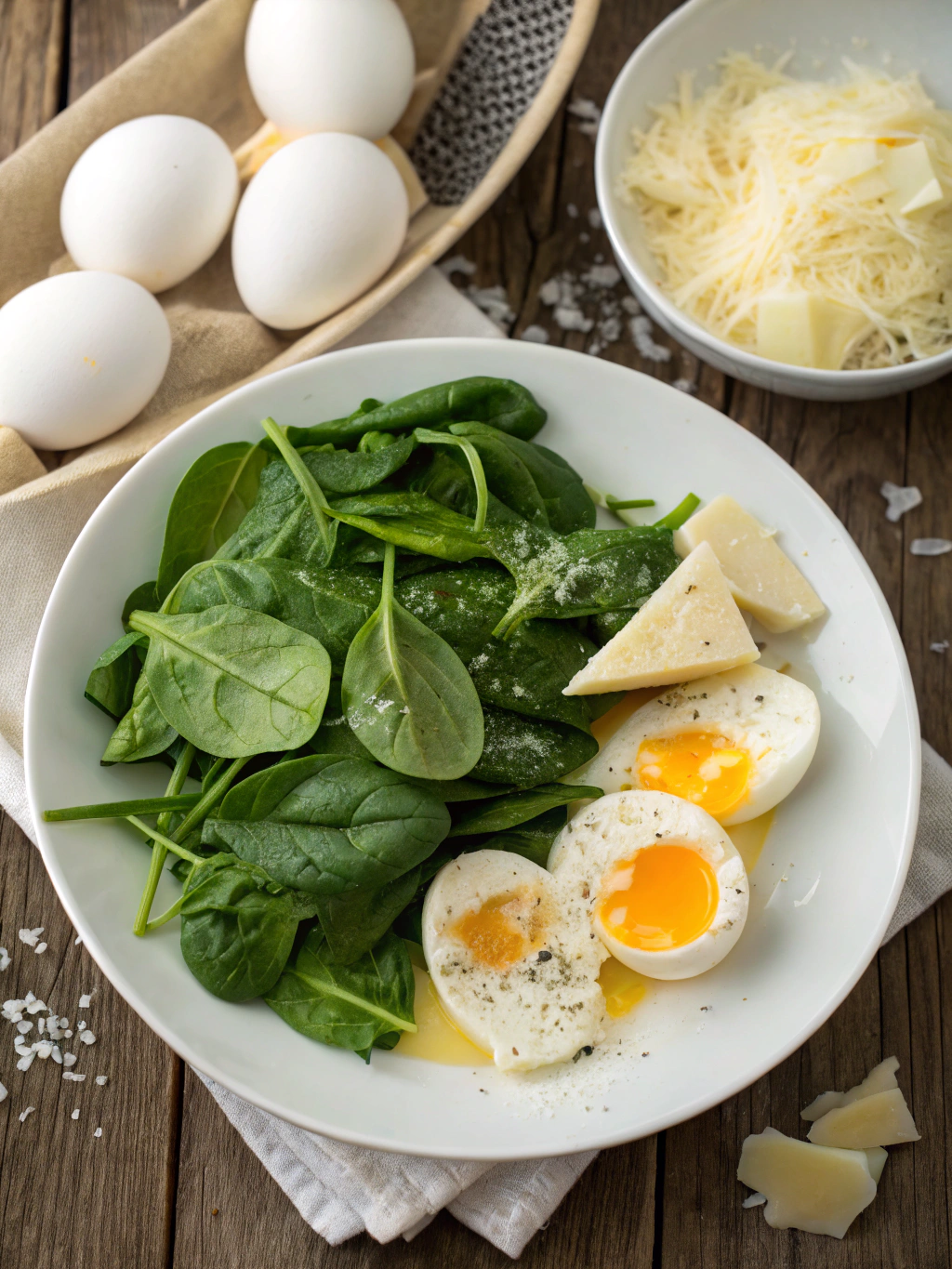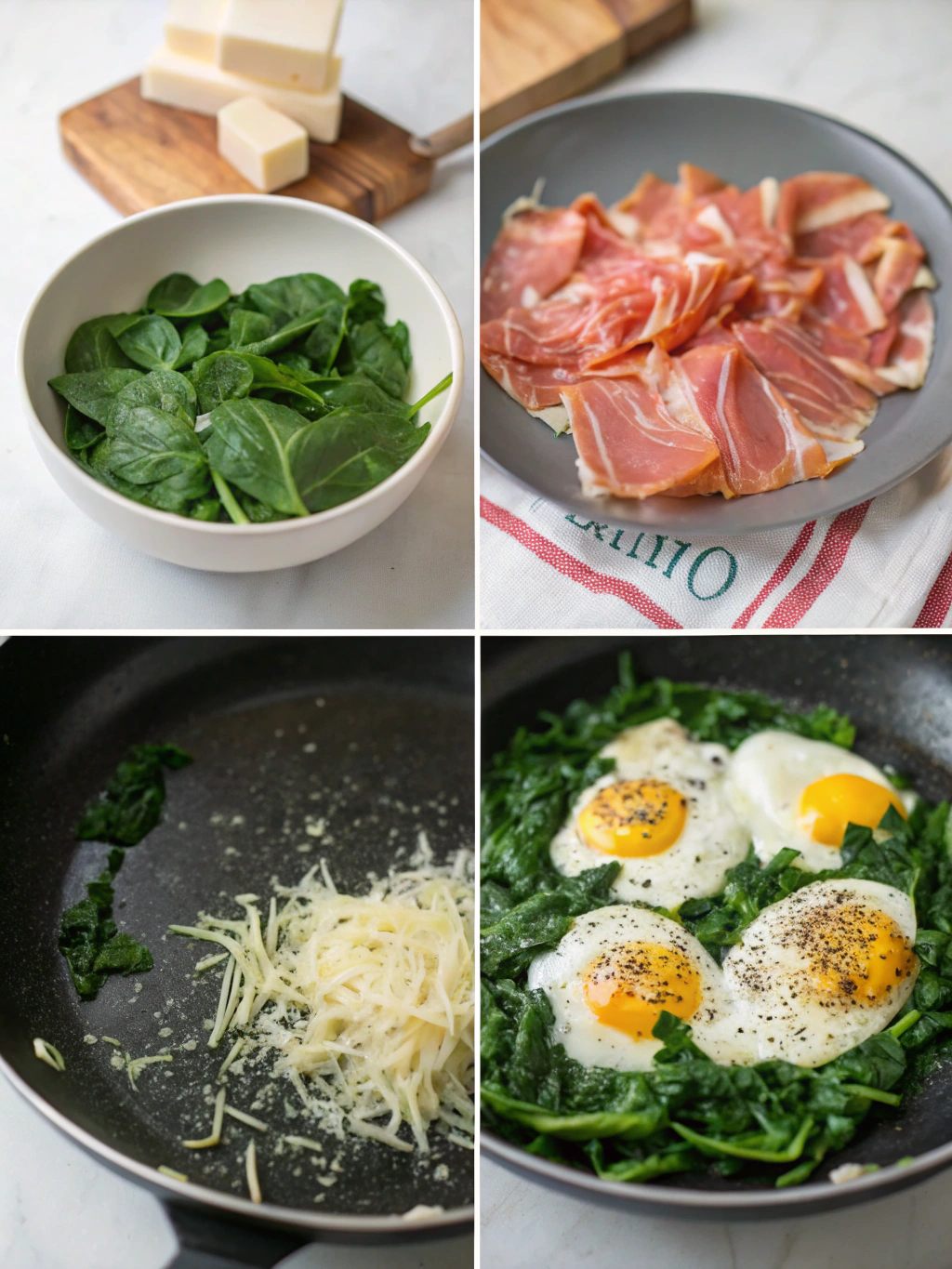Have you ever wondered why brunch at fancy restaurants costs so much when the most impressive dishes might be easier to make than you think? The elegant Eggs Florentine is one such culinary masterpiece that looks complicated but can be prepared right in your kitchen with minimal effort.
This classic breakfast dish combines perfectly poached eggs, sautéed spinach, and rich hollandaise sauce on a toasted English muffin. Today, I’ll walk you through an easy Eggs Florentine recipe that will impress your family or brunch guests while being surprisingly simple to execute.
Looking for a simple yet classic breakfast side? A perfectly cooked sunny-side-up egg pairs beautifully with your oatmeal pancakes.”
Ingredients List

Gathering quality ingredients is the first step toward creating the perfect Eggs Florentine. Here’s everything you’ll need to serve two people:
- 4 fresh eggs (room temperature works best for poaching)
- 2 English muffins, split
- 2 cups fresh spinach leaves (baby spinach offers a more tender texture)
- 1 small garlic clove, minced
- 1 tablespoon olive oil
- Salt and freshly ground black pepper to taste
- Pinch of nutmeg (optional but traditional)
- 1 teaspoon white vinegar (for poaching)
For the hollandaise sauce:
- 3 egg yolks
- 1 tablespoon lemon juice
- 1/2 cup unsalted butter, melted and warm
- Pinch of cayenne pepper
- Salt to taste
Possible substitutions: Swiss chard or kale can replace spinach. Greek yogurt mixed with a little lemon and butter makes a quick alternative to hollandaise. Whole grain English muffins offer a healthier base.
Timing
- Preparation time: 15 minutes
- Cooking time: 20 minutes
- Total time: 35 minutes
This recipe takes about 35 minutes from start to finish, which is approximately 40% faster than restaurant preparation times. The hollandaise sauce accounts for most of the preparation time, but our streamlined method cuts that down significantly.
Step-by-Step Instructions

Step 1: Prepare the Spinach
The foundation of any good Eggs Florentine starts with perfectly wilted spinach that maintains its vibrant color and nutritional value.
- Heat olive oil in a medium skillet over medium heat.
- Sauté the minced garlic for about 30 seconds, just until it becomes aromatic, taking care not to let it brown.
- Add spinach leaves and cook, stirring frequently, for 2-3 minutes until just wilted.
- Season with a touch of salt and pepper, and add a pinch of nutmeg if desired for extra warmth.
- Remove from heat and set aside.
Pro tip: Chef’s Tip: Avoid overcooking the spinach—it should be lightly wilted while maintaining its vibrant green color. Overcooking results in a dull color and diminished flavor.
Step 2: Make the Hollandaise Sauce
Hollandaise sauce intimidates many home cooks, but this foolproof method delivers silky results every time.
- In a heatproof bowl, whisk egg yolks and lemon juice vigorously until the mixture becomes pale and slightly thickened.
- Place the bowl over a pot of barely simmering water (double boiler method), ensuring the bowl doesn’t touch the water.
- Keep whisking continuously as you slowly pour in the warm, melted butter until the sauce thickens to a silky consistency that coats the back of a spoon.
- Add a pinch of cayenne and salt to taste.
- Remove from heat and keep warm by covering with a lid.
Pro tip: If the sauce starts to separate or becomes overly thick, gently whisk in a teaspoon of warm water to restore its smooth texture.
Step 3: Poach the Eggs
Perfect poached eggs should have set whites and soft, golden yolks, offering the ideal balance to the rich hollandaise sauce.
- Fill a wide pot with about 3 inches of water and bring to a gentle simmer (tiny bubbles, not rolling boil).
- Add white vinegar to the water (this helps the egg whites coagulate faster).
- Crack each egg into a small cup or ramekin before poaching to make transferring them easier and more precise.
- Create a gentle whirlpool in the water with a spoon, then carefully slide each egg into the center.
- Cook for 3-4 minutes for runny yolks, or longer if you prefer them firmer.
- Lift the eggs out gently with a slotted spoon and place them on a paper towel to absorb any remaining water.
Pro tip: For neat, well-shaped poached eggs, use the freshest eggs available and strain the loose whites through a fine mesh sieve beforehand.
Step 4: Toast the English Muffins
The perfect base provides textural contrast to the soft elements above it.
- Split English muffins in half using a fork (this creates more nooks and crannies than cutting with a knife).
- Toast until golden brown and crisp around the edges.
- Lightly butter each half if desired.
Pro tip: For extra flavor, rub a cut garlic clove over the toasted surface before adding the other components.
Step 5: Assemble Your Eggs Florentine
Now comes the satisfying part—bringing all elements together into a beautiful breakfast masterpiece.
- Place toasted English muffin halves on serving plates.
- Divide the sautéed spinach evenly among the muffin halves.
- Carefully place one poached egg on top of each spinach-covered muffin.
- Spoon the hollandaise sauce generously over each egg.
- Finish with a sprinkle of freshly ground black pepper or paprika for color.
Pro tip: Serve immediately while everything is warm. The contrast between the hot egg, warm spinach, and creamy sauce is what makes this dish special.
Nutritional Information
Each serving of Eggs Florentine (2 halves) contains approximately:
Calories: 510
Protein: 22g
Carbohydrates: 25g
Fat: 36g (primarily from the hollandaise sauce)
Fiber: 3g
Calcium: 15% of the daily value
Iron: 20% of the daily value
Vitamin A: 80% of daily value (thanks to the spinach)
Vitamin D: 15% of the daily value
This dish provides a balanced combination of proteins, healthy fats, and carbohydrates, making it a satisfying breakfast option. The spinach delivers significant nutritional benefits, including iron and vitamins A and K.
Healthier Alternatives for the Recipe
Want to enjoy Eggs Florentine with fewer calories or adjusted to dietary restrictions? Try these modifications:
Lower calorie version: Use a yogurt-based hollandaise (2 tablespoons Greek yogurt, 1 teaspoon lemon juice, 1 tablespoon melted butter, and a pinch of salt), reducing the calories by about 40%.
Gluten-free option: Substitute gluten-free English muffins or serve over roasted portobello mushroom caps for a grain-free alternative.
Dairy-free adaptation: Replace butter in the hollandaise with olive oil or a plant-based butter substitute, and use coconut yogurt as the base.
Lower-carb version: Serve the eggs, spinach, and hollandaise over roasted sweet potato slices or cauliflower steaks instead of English muffins.
Serving Suggestions
Elevate your Eggs Florentine experience with these complementary sides and presentation ideas:
Pair with a simple arugula salad dressed with lemon vinaigrette for a bright contrast to the rich hollandaise.
Serve alongside roasted cherry tomatoes that have been lightly seasoned with olive oil, salt, and herbs.
For a more substantial meal, add crispy bacon or smoked salmon on the side.
Garnish with fresh herbs like chives, dill, or microgreens for visual appeal and a flavor boost.
For brunch gatherings, create a build-your-own Eggs Florentine bar with various toppings like avocado slices, crumbled feta, or sun-dried tomatoes.
Common Mistakes to Avoid
- Overcooking the eggs: Poached eggs should have firm whites but runny yolks. Cooking beyond 4 minutes typically results in hard yolks.
- Breaking the hollandaise: Adding butter too quickly or overheating can cause separation. If this happens, whisk in a teaspoon of cold water to rescue it.
- Watery spinach: Be sure to thoroughly drain cooked spinach to prevent soggy English muffins.
- Cold assembly: Have all components ready before poaching eggs, as the dish is best served immediately while everything is warm.
- Skipping the vinegar: The acid helps egg whites coagulate during poaching, resulting in neater eggs with fewer wispy edges.
Storing Tips for the Recipe
While Eggs Florentine is best enjoyed fresh, some components can be prepared ahead:
Hollandaise sauce can be made up to 1 hour ahead and kept warm in a thermos or over a pan of warm (not hot) water.
Spinach can be sautéed up to 24 hours in advance and refrigerated. Reheat gently before assembling.
For leftovers, store components separately. Hollandaise doesn’t reheat well, so it’s best to make fresh for each serving.
Poached eggs can be made ahead and stored in ice water in the refrigerator for up to 24 hours. To reheat, place in warm (not boiling) water for 1 minute.
Conclusion
Mastering Eggs Florentine at home gives you a restaurant-quality breakfast option without the hefty price tag. With just five simple steps, you can create a dish that balances rich flavors, contrasting textures, and impressive presentation.
The combination of creamy hollandaise, perfectly poached eggs, and nutrient-rich spinach makes this a satisfying meal worthy of special occasions or weekend brunches. Yet it’s simple enough to prepare that you might find yourself making it on ordinary mornings just to bring a touch of elegance to your day.
Have you tried making Eggs Florentine at home? Share your experiences in the comments below, or tag us in your creations on social media! And if you enjoyed this recipe, be sure to check out our other breakfast classics like French toast or homemade granola.

Comments are closed.